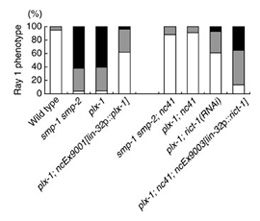Research Abstract
線虫(C.elegans)において、セマフォリンによってTORの結合相手はRictorからRaptorに切り替わる
Target of rapamycin(TOR)は、細胞の増殖や代謝の中心的な調節因子で、2つの機能的に異なる複合体であるTORC1およびTORC2を形成する。
A shift of the TOR adaptor from Rictor towards Raptor by semaphorin in C.elegans
2011年9月27日 Nature Communications 2 : 484 doi: 10.1038/ncomms1495

Target of rapamycin(TOR)は、細胞の増殖や代謝の中心的な調節因子で、2つの機能的に異なる複合体であるTORC1およびTORC2を形成する。 TORはTORC1ではRaptor、 TORC2ではRictorという異なるアダプタータンパク質と結合するが、これら2つのTORCの形成がどのように調節されているのかは解明されていない。本論文では、線虫(Caenorhabditis elegans)におけるセマフォリン–プレキシンシグナル伝達によるTOR複合体形成の制御を示す。セマフォリンおよびプレキシン変異体では、TOR–Raptor結合が減少する一方、TOR–Rictor結合は増加し、これと同時にTORC1活性の低下およびTORC2活性の上昇がみられる。これらの変異体における表皮の異常はTORC2シグナル伝達の阻害、あるいはTORC1シグナル伝達の増強によって抑圧される。逆に、TORC1シグナル伝達の阻害は変異体と類似の表現型を引き起こす。したがって、我々の結果は、TORCの形成がセマフォリンシグナル伝達におけるとりわけ重要な段階であり、その結果、TORC1によって促進されるメッセンジャーRNAの翻訳やTORC2によって調節される細胞骨格のリモデリングを含むさまざまな変化が引き起こされることを示す。
- 名古屋大学大学院理学研究科 生命理学専攻
The target of rapamycin (TOR), a central regulator for cell growth and metabolism, resides in the two functionally distinct complexes TORC1 and TORC2, which are defined by their adaptors Raptor and Rictor, respectively. How the formation of the two TORCs is orchestrated remains unclear. Here we show the control of TOR partnering by semaphorin-plexin signalling in Caenorhabditis elegans. In semaphorin and plexin mutants, TOR-Raptor association decreases whereas TOR-Rictor association increases, concomitantly with TORC1 down- and TORC2 up-regulation. Epidermal defects in the mutants are suppressed by inhibiting TORC2 or reinforcing TORC1 signalling. Conversely, inhibition of TORC1 signalling phenocopies the mutants. Thus, our results indicate that TORC formation is a singularly important step in semaphorin signalling that culminates in diverse outcomes including TORC1-promoted messenger RNA translation and TORC2-regulated cytoskeletal remodelling.

